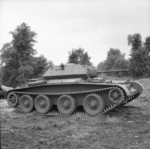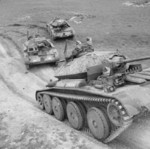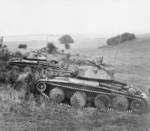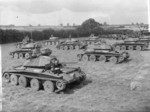Cruiser Mk V Covenanter
| Country | United Kingdom |
| Primary Role | Cruiser Tank |
Contributor: Alan Chanter
ww2dbaseWith the cancellation of the planned A.14 and A.16 heavy cruiser tank projects, the London Midland Scottish Railway workshops at Derby in central England, United Kingdom were presented with a revised specification requiring them to undertake the development of a new cruiser tank, using as many components of the existing A13 tank as possible.
ww2dbaseThe resultant A13 Mark III Cruiser Mark V, to which the name Covenanter was added, was an elegant good-looking tank with a low silhouette and incorporating the same excellent suspension system, developed by the American engineer J. Walter Christie, that had been employed on the earlier British cruisers. The Ministry's specification was basically the same as for the Cruiser Mark IVA with a turret mounted 2-pounder main gun and 30-millimeter armour protection. However it was specified that the effectiveness of protection be increased with both an improved ballistic shape and by lowering the height of the tank. To this end the LMSR were assisted by Nuffield Mechanization on the development of a characteristic lozenge-shaped turret (which in early models had a distinctive axle-shaped external gun mantlet) to provide a good deflection of shot. An important innovation too was the adoption of the Wilson epicyclic steering system which gave more efficient and flexible control of the tank than had previously been possible.
ww2dbaseAfter the fall of France there were only 50 tanks remaining in England. Every tank produced after Dunkirk would need to go directly off the assembly-line straight to field units. Whatever British industry could make in 1940 had to be churned out at once, regardless of quality, to rearm the rescued British Expeditionary Force (BEF); indeed Winston Churchill insisted that, for the time being, all research and development should be stopped to allow every ounce of energy to be concentrated on production.
ww2dbaseNo modifications or new designs was allowed, nor any time allowed for engineering trials or tests of equipment under development. So, with this immediate demand for quantity at the expense of quality only those tanks already in, or about to, enter production (e.g. Matilda, Valentine, Cruisers Mk. IV, V, VI, and the new Churchill), all armed with the obsolescent 2-pounder gun were rolled out in growing numbers while the next generation of armoured vehicles waited in abeyance.
ww2dbaseFor the Covenanter the main flaw lay with its power unit. Designed specifically for the tank by the firm of Meadows, the new 12-cylinder engine was simply not up to the job, and in the haste to re-equip the Army this untried feature was cleared without waiting to test the pilot model.
ww2dbaseThe cooling system did not work and despite modification of the air intake louvres (situated at the front-left hand side next to the driver) in Army workshops (the modified vehicles being known as Covenanter IIs) and the later introduction of two further Marks (Covenanter III and IV before the end of 1941) the persistent reliabilty problems could never be satisfactorily resolved. Other service concerns involved the excessive ground pressure of the narrow tracks and the somewhat thin flank and rear armour.
ww2dbaseDeliveries began in mid-1940 but the engine cooling problems were soon recognised as making the Covenanter quite unsuitable for use in tropical climates, and it was therefore restricted to home defence and training duties only. Ultimately some 1,771 Covenanters would be built before manufacture ceased in 1943 and although it was never used in battle it would, for a while, play an important part in the defence of the United Kingdom; firstly in helping to re-equip the battered 1st Armoured Division, back from Calais, and later contributing to the new Armoured Divisions as they were raised. The 9th Armoured Division's tanks, in fact, were almost exclusively Covenanters by the end of 1941. It is a credit to the workers at the railway workshops that so many were built despite the rushed design and the War Office not being able to make up its mind just what sort of tank the army needed. Additionally bad factory management frequently allowed poor workmanship to be passed uncorrected, which added to the poor reputation gained by the Covenanter rank in service hands.
ww2dbaseBut, even with the unsatisfactory Covenanter, British tank production during 1941 amounted to a mere 4,841 vehicles (The German figure according to Heinz Guderian was 2,875), a good proportion of which were the now almost obsolete Matildas and Valentines. It was therefore agreed, at the so-called "Victory Conference" of September 1941, that Britain would need to order 10,500 tanks from American factories (all of them to be cruisers). But it would be a long time before delivery of such a number could actually be achieved.
ww2dbaseSources:
Ian V. Hogg & John Weeks, The Illustrated Encyclopaedia of Military Vehicles (Hamlyn, 1980)
B. T. White, Tanks and other AFVs of the Blitzkrieg Era 1939-41 (Blandford Press, 1972)
A. J. Smithers, Rude Mechanicals (Grafton Books, 1989)
Eric Offord, British Tanks 1914-45 (War Monthly Issue 15)
Major K. J. Macksey, Build up for D-day-Balance of Armour (The Tank Story, Purnells History of the World Wars)
Last Major Revision: Apr 2015
SPECIFICATIONS
A13 Mk V Covenanter
| Machinery | Meadows 16-litre 300 bhp flat-12 type-DAV petrol engine rated at 300 bhp |
| Suspension | Christie suspension |
| Armament | One turret-mounted 40mm 2-Pdr QF gun and one co-axial 7.92mm. Besa machine-gun |
| Armor | 7-40mm |
| Crew | 4 |
| Length | 5.79 m |
| Width | 2.61 m |
| Height | 2.23 m |
| Weight | 18.3 t |
| Speed | 50 km/h |
| Range | 150 km |
Photographs
 |  |  |  |
Did you enjoy this article or find this article helpful? If so, please consider supporting us on Patreon. Even $1 per month will go a long way! Thank you. Share this article with your friends: Stay updated with WW2DB: |
Visitor Submitted Comments
All visitor submitted comments are opinions of those making the submissions and do not reflect views of WW2DB.
- » WW2DB's 20th Anniversary (29 Dec 2024)
- » Wreck of USS Edsall Found (14 Nov 2024)
- » Autumn 2024 Fundraiser (7 Nov 2024)
- » Nobel Peace Prize for the Atomic Bomb Survivors Organization (11 Oct 2024)
- » See all news
 |
- » 1,150 biographies
- » 337 events
- » 44,024 timeline entries
- » 1,242 ships
- » 350 aircraft models
- » 207 vehicle models
- » 375 weapon models
- » 123 historical documents
- » 260 facilities
- » 470 book reviews
- » 28,597 photos
- » 432 maps
Thomas Dodd, late 1945
Please consider supporting us on Patreon. Even $1 a month will go a long way. Thank you!
Or, please support us by purchasing some WW2DB merchandise at TeeSpring, Thank you!
24 Feb 2016 07:11:06 AM
its confusing it tells about its past, not how it is now